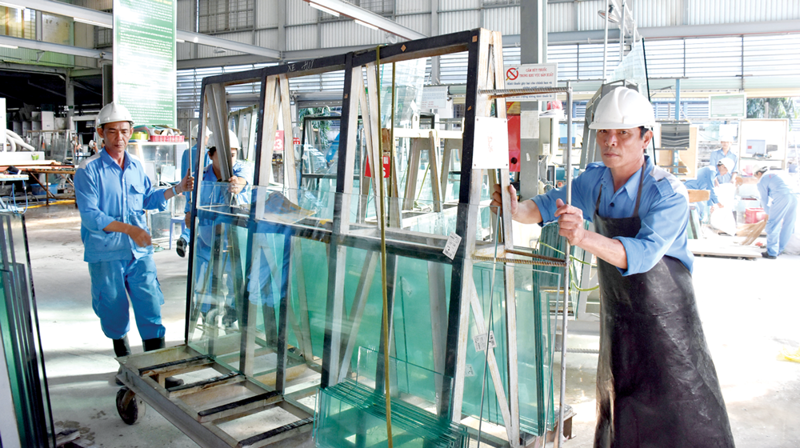At the “Banking Capital Contributes to Promoting the Private Economy” seminar, held recently in Hanoi, a number of businesses proposed that the banking sector create mechanisms allowing private enterprises to secure long-term loans of up to ten years for investing in research, science, and technology. In addition, policies offering preferential interest rates would incentivize businesses to invest in factories, production, and long-term growth. Deputy Governor of the State Bank of Vietnam (SBV) Dao Minh Tu said that through various policy mechanisms, particularly credit provision with reasonable interest rates, banks have helped businesses expand their operations and enhance their competitiveness.
Strengthening credit access
Mr. Tu also highlighted that the Party, State, and government see the private sector as a major driving force for the economy. For many years, the SBV has steered credit in a manner that directly supports the growth of the private sector. “The private sector’s outstanding loans currently account for nearly 44 per cent of the total credit balance in the economy,” he said. “In 2024, the total lending volume reached about VND23 trillion ($920 million), with nearly VND21 trillion ($840 million) in loan repayments. The SBV also offers various preferential interest rate policies, with small and medium-sized enterprises (SMEs) being among the five groups benefiting from these low rates.” He noted that credit institutions today treat all economic sectors equally when lending, and mechanisms and policies are designed to be flexible and accessible. The key factor for businesses to access credit is their ability to repay loans.
Mr. Nguyen Van Than, President of the Vietnam Association of Small and Medium Enterprises (VINASME), pointed out that banks are special businesses facing significant pressure to recover capital and pay back interest to depositors, as well as to meet revenue and profit expectations among shareholders. Given the current challenges in the capital market, private enterprises, especially SMEs, are left with few options and must rely heavily on banks. Therefore, businesses must proactively improve transparency in their cash flow, strengthen management capabilities, and present feasible business plans to more easily access credit capital.
He also suggested that VINASME plans to collaborate with large enterprises to introduce SMEs into their supply chains, creating opportunities for them to become essential links in the product creation process, while leveraging the reputation of these large businesses to gain better access to bank capital.
Financing for innovation
Mr. Nguyen Kim Hung, Chairman of the Board of Directors at the Kim Nam Group, said the Politburo’s issuance of two important resolutions on the private economy in the new context has boosted the entrepreneurial spirit, production, business development, and recovery and growth after a difficult period. “For breakthrough growth, businesses are hoping that the Ministry of Finance and the SBV will introduce financial support programs and policies for innovation, he said. “Currently, even banks do not have a separate loan package for innovative enterprises. Once there are specific regulations, we hope that banks will allocate a certain amount of capital for this sector.” Mr. Hung also proposed that the SBV present to the government a loan package with the best possible preferential interest rates for businesses investing in technology innovation.
In response to Mr. Than’s comments on the value chain linkage model, Deputy SBV Governor Tu noted that, 13 years ago, the banking sector experimented with lending for 21 models, all of which failed, except for one successful export flower chain in Da Lat, which succeeded because of foreign investment in capital and technology. “A value chain must ensure that everyone benefits,” he said. “If the linkage is weak, it will be very difficult. Lending through a value chain without collateral offers many benefits to participants, businesses, the economy, and even commercial banks. However, success depends on the participants in the chain.”
Regarding the mechanism for a loan package dedicated to science, technology, and innovation, he agreed that this is an issue that needs to be addressed now to find a solution. Banks also recognize that science, technology, and innovation are competitive advantages for any business, and falling behind in this race will lead to failure. Innovation requires resources, but relying solely on banks will not be enough, and given the nature of bank capital, they cannot meet all capital needs.
Experts agreed with the view that private enterprises need support from many other sources, such as the budget, investment funds, and capital raising through bonds. Each debt instrument is suitable for the characteristics of different sectors. Therefore, it is essential to quickly unlock the capital market so that the private economy has enough resources to break through.
Regarding interest rates, Mr. Tu said the interest rate level would be relatively balanced by the end of March. Preferential interest rate packages will also continue to be applied to specific sectors.
Unlocking growth potential
Mr. Nguyen Dinh Cung, former Director of the Central Institute for Economic Management (CIEM), said that in order to achieve the 8 per cent economic growth target set for 2025 and double-digit growth in subsequent years, the private sector must grow by over 10 per cent annually in terms of scale, output, and sales. According to Mr. Cung, in order to achieve this growth rate, two key pillars need to be strengthened.
The first is institutional reform. It is necessary to reform institutions to remove this “bottleneck of bottlenecks” and create breakthroughs. The focus of this pillar is to eliminate overlapping, redundant, unclear, inefficient, and non-transparent legal regulations.
The legal system should shift away from a “prohibit what we cannot manage” approach, meaning “allowing businesses to operate within the scope of the government’s understanding”, to a more open legal system that fosters a truly free, creative, and equitable business environment with low compliance costs.
The second pillar is ensuring equal access to resources for private enterprises. The government needs to create an environment where businesses can access capital, land, technology, and data in a timely, sufficiently large, and coordinated manner, allowing the private sector to make a breakthrough to a new level, from micro to small, and small to large, which is an extremely challenging threshold for businesses.
According to Mr. Cung, businesses cannot remain dependent on credit capital forever and need significant long-term investment. Therefore, the government needs to open up the capital market with more diversified fundraising channels to reduce the burden on banks. It is necessary to develop the capital market with investment funds, which Vietnam is currently lacking. This has hindered many businesses from growing.









 Google translate
Google translate